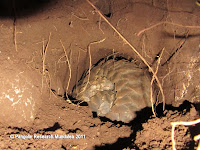While the RF performance of the radio tag used on Kasupi was very satisfactory and the tag's size and weight were not a problem, its ruggedness needs further improvement. A Cape Pangolin uses the scales on its back to abrade the walls of burrows to enlarge its den, sleeping curled up in an armoured ball (as shown in the photos below deep in a aardvark hole). The flexible trailing antennae from the tag can therefore become bent, although the RF transmission was not impaired.
(Photos in this blog post are courtesy of Debbie Shaw)
After a week of attachment, treatment in this way and pushing through heavy undergrowth, wear to the front and top of the tag was evident despite it still working electrically, with a fracture appearing between the hard and softer parts of the encapsulation, see below.
Unfortunately, signals from the tag were lost a few days afterwards - we speculate that water from the torrential downpours at that time might have got into the tag and affected the electrical functioning. We are continuing to search for the pangolin and check for any tag transmissions as the dry season starts. Meanwhile tags with a more rugged outer casing design and allowing better attachment position have been manufactured by Biotrack Ltd, UK after our discussions together, These weigh about 35g and are being shipped to Mundulea (see below). Our aim is a tag which will last for more than a year of pangolin use - matching the tag's battery life.





No comments:
Post a Comment